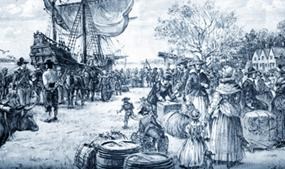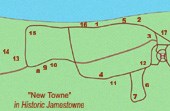
NPS artist Sydney King That every ship arising in this colony from England, or any other parts, shall, with the first wind and weather, sale upp to the porte of James Citty, and not to unlade any goods or breake any bulke before she shall cast anchor there, uppon payne that the captayne and mayster of the sayd ship shall forfeite the sayd goods or the value thereof, and shall have and suffer one mounthes imprisonment. From Act XX, the first of March, 1631-2
Jamestown provided the English with a deep-water port, as well as a defensible settlement location. Like the Virginia Indians, the English tended to locate on or near major waterways, which allowed for easier transportation as well as a ready source of food. Though Jamestown soon moved beyond the confines of a small, palisaded fort, the James River continued to be an important feature of the city. The waterfront was a bustling place throughout the seventeenth century, punctuated by wharves where imported goods were unloaded and hogshead barrels of tobacco were rolled aboard vessels bound across the broad Atlantic.
Sporadically throughout the century, laws were passed that designated Jamestown as the colony’s sole port of entry. The mercantile focus of the town was enhanced by these acts, which obligated all ships to load and unload at the colony’s governmental seat. |
Last updated: February 26, 2015

